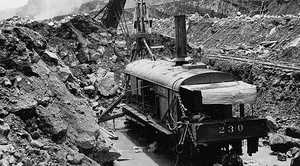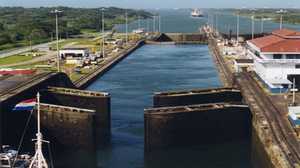Chief Engineers of the Panama Canal
The first chief engineer of the Panama Canal project, John Findley Wallace, resigned in frustration after only a year on the isthmus. His replacement, John Stevens, lasted just 20 months, but oversaw the engineering of the canal's lock system and restructuring of the Panama Railroad -- two hurdles critical for the project's success. In 1907, Colonel George Washington Goethals became the third and final Chief Engineer, shepherding the project to its completion in 1914. All three men faced innumerable challenges, including a complex bureaucracy, pressure from American politicians, and the constant threat of yellow fever and malaria, all while planning the construction and execution of the world's largest lock canal to date.
John Findley Wallace
Born in Fall River, Massachusetts, John Wallace studied at Monmouth College in Western Illinois before receiving a Civil Engineering degree from the College of Wooster in 1882. Wallace began his career as Assistant Civil Engineer for the U.S. Engineering Corps, focusing on river and harbor work on the Upper Mississippi.

Over the next 15 years, he was promoted to Chief Engineer and finally General Manager of the Illinois Central Railroad.
On May 6th, 1904, President Theodore Roosevelt appointed Wallace Chief Engineer of the Panama Canal Project. The job awarded Wallace a $25,000 annual salary -- the highest of any government employee other than the President. On June 21, Wallace, along with assistant engineer William Karner, set sail on the Allianca from New York. After a rough weeklong voyage, the ship arrived in Colón, Panama during the rainy season. The streets were thick with impassible mud and houses elevated just a few feet above dirty, foul smelling water. Wallace and his men were not optimistic about the future in their new home.
Wallace realized almost immediately that the Isthmus' harsh terrain would be a serious obstacle to construction. The task ahead of him seemed impossible: to dig a channel 50 miles in length and 30 feet below sea level stretching from the Atlantic Ocean to the Pacific coast. He would have to cut through dense jungle, control parts of the flood-prone Chagres River and haul away sections of the Culebra Mountain hundreds of feet above sea level. Daunted, Wallace asked for more time to survey the area, but Roosevelt's directive to "Make the dirt fly!" prevented any further delay.
To meet the government's demands for fast, visible progress on the canal, Wallace attempted to excavate the spoil as quickly as possible, but flooding and landslides caused repeated setbacks. The delays damaged morale among workers already suffering from terrible food and living conditions.
Logistical problems added to the inefficiency. At the start of the project, the laborers only had at their disposal the antiquated machines left behind a decade earlier. Soon Wallace ordered newer equipment from the U.S., but the giant steam shovels excavated more spoil than the existing train infrastructure could remove, forcing Wallace to operate them at 25% of their peak efficiency or less.
Wallace also faced bureaucratic challenges from Isthmian Canal Commission (ICC). A seven-member presidential committee was established to help avoid the inefficiency and corruption that had plagued the French 15 years earlier. The ICC had to approve every decision Wallace made in the Canal Zone. With engineers filling out more than 1,000 work request forms weekly, even the simplest tasks often took months to complete.
Overwhelmed, Wallace resigned abruptly in June 1905. His successor was railroad mastermind John Stevens, engineer of the Great Northern Railroad that traversed the Pacific Northwest. Right at the start of his tenure Stevens did the one thing that Wallace failed to do -- stop digging.
John Stevens
John Stevens was appointed Chief Engineer of the Panama Canal Project in 1905 based on his accomplishments at the Great Northern Railway. The fearless Maine native had helped expand American rail lines west and thus contributed to the white settlement of the Pacific Northwest.

President Theodore Roosevelt knew Stevens was the right man to tackle the Panama Canal Project. The Canal's "affairs [were] in a devil of a mess," Roosevelt said. The foremost civil engineer of his day, Stevens approached the project as a humanitarian effort, as well as an engineering one. With confidence and morale desperately low among the workers, one of Stevens' first actions was to introduce a food car, a haven of entertainment and much-needed sustenance for the men.
In addition, Stevens parted company with most high-ranking officials by taking seriously the threat of yellow fever-carrying mosquitoes. The last case of yellow fever was reported on November 11, 1905, shortly after Stevens' arrival.
Stevens drew up logical plans for the canal's construction. One of the first things he did was to ask 27-year-old manager Ralph Budd to take on the difficult job of rebuilding the railroad across the Panamanian isthmus. The finished product was a railroad system efficient enough to operate around the clock, effectively acting as a giant conveyor belt for excavated spoil.
Another substantial challenge was cutting through hundreds of feet of mud and rock in the Culebra Mountain. Noting how little progress his predecessors had made excavating this area, Stevens realized that the plan to build a sea-level canal was impossible. He endorsed a new plan consisting of locks, dams and a new artificial lake in the middle of what was then rainforest. Stevens lobbied for the ICC's approval of this change, which ultimately proved crucial to the success of the project.
Engineering advances, including the new plan for a lock system, were coupled with social ones. Lacking the advanced degrees of many of his colleagues, Stevens shunned any special treatment as an officer. The living quarters reserved for him, palatial by camp standards, remained empty as he bunked closer to the workers.

Straight-talking and cigar-chomping (a habit that earned him the nickname "Big Smoke"), he and politics didn't mix well. However, the steep expectations and high pressure that came with the title of Chief Engineer led to his resignation in 1907. The letter of resignation came at the beginning of February, after President Roosevelt had come to the isthmus only two months before in a wildly successful tour of the construction site.
Although Stevens was only on the project for 20 months, his successful lobbying for the lock system ensured the ultimate completion of the canal. His railroad system worked seamlessly for the remainder of the construction period, and his involvement in the lives of the laborers improved both the health and morale of the work force. Although the next and final Chief Engineer of the Canal, Colonel George Washington Goethals, earned the nickname "the Genius of the Panama Canal" for seeing the canal to its completion, Goethals often said that his predecessor, John F. Stevens, deserved the title.
George Washington Goethals
President Roosevelt appointed Colonel George Washington Goethals the new Chief Engineer of the Panama Canal project on February 26, 1907. As a military officer, Goethals was bound to the assignment by duty, but he was also personally determined to see it through to completion. With his militaristic administrative style, the Colonel made significant production reforms and helped bring the project to completion ahead of schedule in 1914.

Born in Brooklyn, New York, Goethals graduated second in his class from West Point. Appointed as a 2nd Lieutenant in the Army Corps of Engineers, Goethals was promoted to Captain in 1891. The same year, he oversaw construction of the Riverton Lock at Colbert Shoals in Alabama where he won accolades for installing a single, 26-foot lock instead of several smaller locks. This experience, along with Goethals' militaristic leadership style brought him to Roosevelt's attention.
Civilian engineers in Panama, however, regarded the new military leadership with trepidation. Goethals attempted to reassure the workers that "any man who does duty will never have any cause to complain of militarism." Although no longer an Army commander, Goethals attacked the project as if he were at war. "I now consider that I am commanding the Army of Panama, and the enemy we are going to combat is the Culebra Cut and the locks and dams at both ends of the canal," Goethals announced to visiting Congressmen in 1907.
Almost immediately after Goethals' arrival, workers put his leadership to the test. In May of 1907, the steam-shovel crew went on strike, demanding a steep and unprecedented wage increase. Refusing to capitulate, Goethals hired strikebreakers until he had replaced the entire striking team. The colonel's uncompromising attitude gave him an unquestionable hold over his workers.
In his first year on the job, Goethals achieved astounding results. Finding the "Stevens system" to be a successful model, Goethals applied his predecessor's technological achievements wherever possible. In 1908, laborers removed 37 million cubic yards of spoil from the Culebra Cut -- half of what it took two French teams nearly 17 years to accomplish.
Despite his somewhat militaristic style and standoffish manner, many canal workers admired Goethals and considered him a fair and honest man. He earned further respect by refusing to wear a military uniform on the isthmus.

Often referred to as the "Czar of Panama," Goethals had power far greater than that of his predecessors; he controlled all aspects of production and society ranging from the damming of the canal to the management of the post office. Many members of the project, including Goethals himself, regarded the construction of the canal not only as an engineering feat, but also as a display of American governance, admittedly with a slightly dictatorial edge.
Goethals' appointment marked a key turning point in the construction of the Canal. Although it was once whispered that the completion of the canal would take a miracle, Goethals' efficacious management helped transition the project through a period of sluggish construction filled with undefeatable obstacles to one of rapid excavation and efficacy. The concept of the canal was no longer just a hazy dream but a reality.








